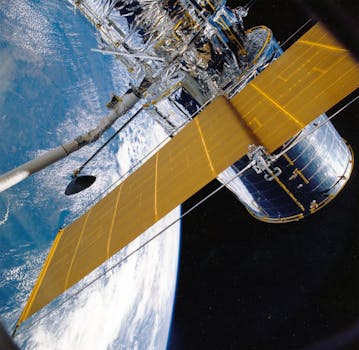GEO Satellites: The Backbone of Global Communications – GEO Satellites

GEO Satellites: The Backbone of Global Communications – GEO Satellites
GEO satellites, or Geostationary Earth Orbit satellites, are a type of satellite that orbits the Earth at an altitude of approximately 36,000 kilometers. GEO satellites are stationed above the equator, where they remain stationary relative to a fixed point on the Earth’s surface. This unique characteristic allows GEO satellites to provide continuous coverage to a specific region, making them an essential component of modern telecommunications.
GEO satellites have been in use for several decades, with the first GEO satellite, Syncom 2, launched in 1963. Since then, the technology has evolved significantly, with modern GEO satellites offering high-gain antennas, advanced propulsion systems, and sophisticated communication payloads. Today, GEO satellites are used for a wide range of applications, including telecommunications, broadcasting, weather forecasting, and navigation.
Applications of GEO Satellites
GEO satellites play a vital role in global communications, providing connectivity to remote areas and enabling international communications. They are used by telecommunications companies to offer services such as broadband internet, voice telephony, and video conferencing. Additionally, GEO satellites are used for broadcasting, allowing television channels to reach a global audience. Weather forecasting agencies also rely on GEO satellites to monitor weather patterns and provide early warnings for natural disasters.
In addition to these applications, GEO satellites are also used for navigation purposes. They provide location information and timing signals, which are used by GPS receivers to determine their exact position and velocity. This technology is essential for a wide range of industries, including aviation, maritime, and land transportation.
Benefits of GEO Satellites
The use of GEO satellites offers several benefits, including global coverage, high-gain antennas, and advanced communication payloads. They provide continuous coverage to a specific region, making them ideal for applications that require constant connectivity. Additionally, GEO satellites are relatively low-cost compared to other types of satellites, making them an attractive option for companies and organizations that require satellite-based services.
Another significant benefit of GEO satellites is their ability to provide high-gain antennas, which allow for more efficient communication and higher data transfer rates. This makes them ideal for applications that require high-bandwidth connectivity, such as video conferencing and broadband internet. Furthermore, GEO satellites are equipped with advanced communication payloads, which enable them to provide a wide range of services, including telecommunications, broadcasting, and navigation.
Challenges Facing GEO Satellites
Despite the many benefits of GEO satellites, there are also several challenges facing the industry. One of the main challenges is the limited availability of orbital slots, which can lead to congestion and interference. Additionally, GEO satellites are vulnerable to space debris, which can cause significant damage and disrupt communication services.
Another challenge facing the GEO satellite industry is the increasing demand for satellite-based services. As the demand for telecommunications, broadcasting, and navigation services continues to grow, the need for more GEO satellites and orbital slots becomes increasingly pressing. This has led to a rise in the development of new satellite technologies, such as high-throughput satellites and satellite constellations.
Future of GEO Satellites
The future of GEO satellites looks promising, with several new developments and technologies on the horizon. One of the most significant advancements is the development of high-throughput satellites, which offer faster data transfer rates and higher capacity. These satellites use advanced technologies such as spot beams and frequency reuse to provide more efficient communication services.
Another development that is expected to shape the future of GEO satellites is the rise of satellite constellations. These constellations consist of multiple satellites that work together to provide global coverage and high-capacity communication services. They offer several benefits, including improved connectivity, higher data transfer rates, and increased redundancy.